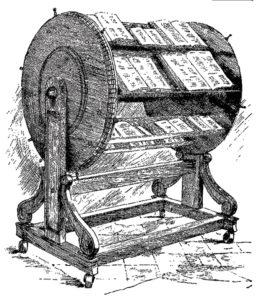I heard about a rejection letter recently that deserves preservation in these days of big-time word-merchandising. “I cannot recall reading,” it said without irony, “a novel as learned, as intelligent, as witty as this, and one with so exact a sense of its place and time. However it is not right for us.” Think long on all that tells you about “us.” A fistful of such letters may reinforce a novelist’s suspicion that most publishers’ first readers are chimpanzees. In less paranoid moments, he may recognize the voices assumed by human beings trying to pretend they aren’t serving a venture in mass production, a theme concerning which it behooves us to be less naïve than they’d like.
Mankind’s first mass-produced item was surely the brick, the second probably the book, the manufacture of which Gutenberg had mechanized by 1454. Mass production enables you to turn out with little trouble a large number of identical artifacts, such as Jeeps or Bibles. Indeed, you can produce with intoxicating ease more copies than people can be found to want. But it grew evident almost at once that mankind’s existing stock of verbal treasures was too small to feed the new technology. Hence instant treasures: books composed solely because entrepreneurs with a press and some type needed something to print. Such books were long suspect. One wanted not to be caught in their company, and keeping out of print was at one time a real writer’s mark of distinction, like staying off the Donahue show. John Donne managed to keep his Songs and Sonnets from printers’ hands right up to his death.
But people with a need are the principal thing mass production produces: hence in these late days something called the Reading Public, a human subspecies imbued with the line-scanning, page-turning habit, that must at all costs not be traumatized by novelty. Much investment rides on the Reading Public’s well-being; Argentinian sheep are tended no more carefully. Its whims are tabulated weekly by computer-processed sales figures. It is ministered to by Sunday book pages and by designers of gadgetry to support a book above one’s bathtub.

Each publisher observes two seasons, spring and fall. Spring culminates in vacations and novels; fall in Christmas and thirty-dollar books you buy for somebody else. And by a persistent misunderstanding, every publisher is beset with correspondence from people who think his main function is the maintenance of the life of the mind.
The writers—a few of them per century—who make a permanent difference: we’re not talking about them, the Joyces, Eliots, Becketts. And apart from them, avant-garde writing is almost exactly as perishable as is Reading Public writing, from which it differs chiefly in soliciting the approval of a smaller group, ranging in size from one—the writer—up to a group of perhaps 1,100. I derive this figure from the typical press runs of small publishing houses, the confidences of itinerant publisher-editors, and observation of the moss on the north side of trees.
Time was when much that’s now left to small presses could stay beneath commercial tents, as when Knopf published Wallace Stevens steadily, from Harmonium to Opus Posthumous. But small sales won’t do any longer, nor will slow sales, not with conglomerate accountants breathing heavily. They breathe especially hard at the mention of a backlist, a warehouseful of miscellaneous titles sold copy by copy on special order. The prestige of a firm used to derive from its backlist, but to the accountant it’s as though Ford kept on hand, at huge cost, a small stock of Model T’s to gratify whimsical nostalgia. Get rid of it all! Concentrate on what moves quickly! And avant-garde publishing, the best like the worst, is almost wholly an affair of backlists. Where first novels can be sent now I’ve no idea.
From “The Traffic in Words,” which appeared in the June 1979 issue of Harper’s Magazine.






















































































